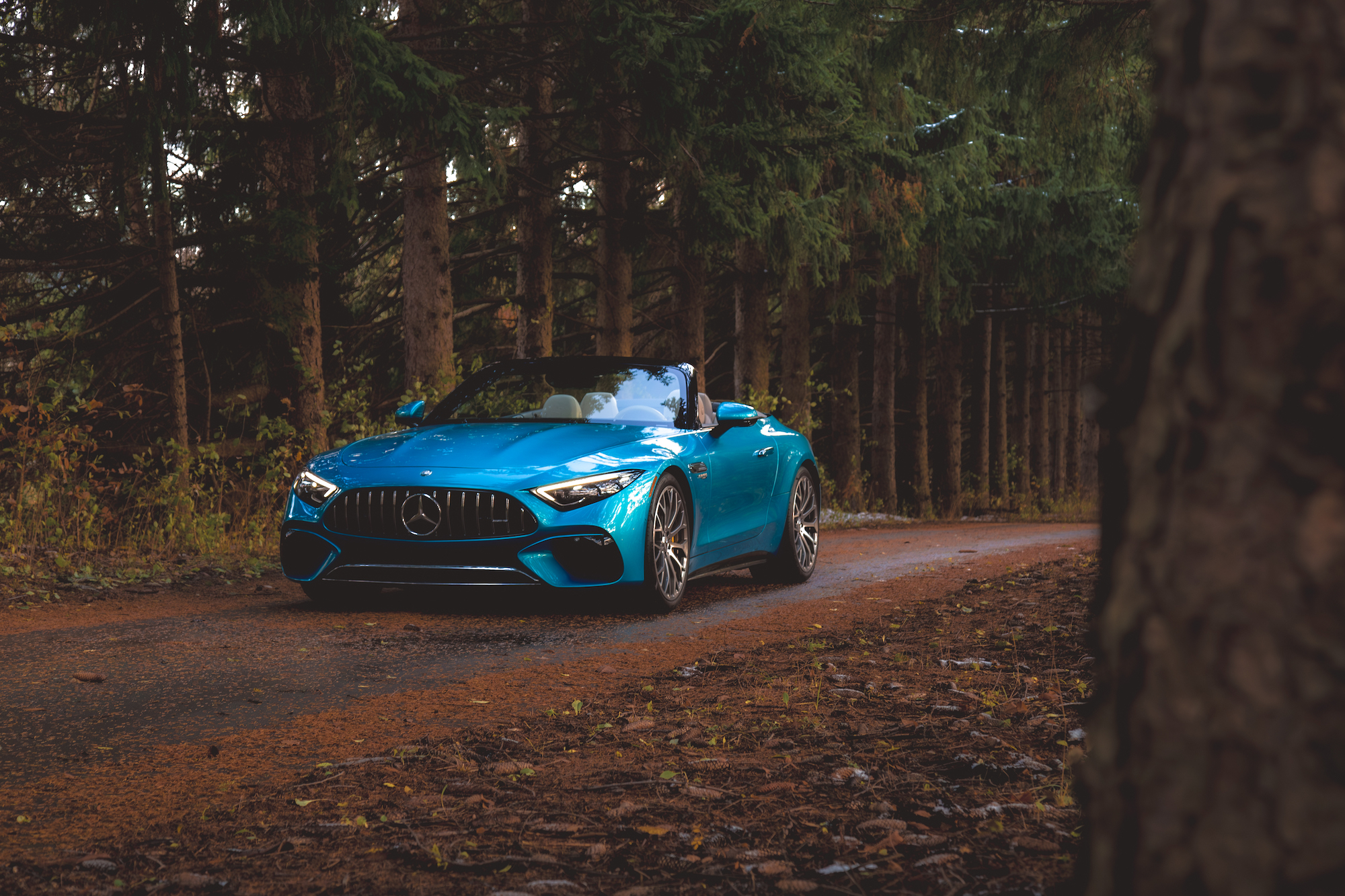The Artura ushers in a new era for McLaren, where less is more and electrification is the future. That means plug-in hybrid efficiency, an engine with two fewer cylinders, and a brisk 0-100 km/h time of 3.0 seconds. Being quick seems to be just a side effect of Woking’s dedication to engineering.

But it’s not the firm’s first foray into the hybrid space. The McLaren P1 took that claim. The Speedtail followed. Now the Artura takes the mantle with a 3.0-litre twin-turbocharged V6, a 7.4 kWh lithium-ion battery, and an electric motor for a total output of 671 horsepower and 531 lb-ft of torque. The 2025 model year Arturas are uprated to 691 hp, but 2023 and 2024 models can get a free software update to achieve the same power figures.

A new 8-speed dual-clutch transmission runs the show and as with every McLaren, the mid-engine and rear-wheel drive layout remains. The carbon tub has been updated to be lighter and stronger and it’s now manufactured in-house in England. The Artura also uses the brand’s first electronically controlled limited-slip differential.

As expected from a supercar flirting with the 700 hp mark, its acceleration is violent. The electric motor fills in that low RPM void, effectively eliminating turbo lag. Once the needle swings past 3,500 rpm, it’s a fervent roller coaster to the horizon. Prodigious speed. It reminds us of the Acura NSX and its hybrid setup – so polished that performance feels almost too easy to extract. Marrying combustion and electric powertrains into a smooth choreographed dance is no small feat either, yet the Artura does it in a way that makes Bollywood scenes appear amateur. And it’s special and involving beyond the numbers too.

Steering feel is the gateway to driver involvement and is arguably the most critical point of contact between car and driver. And it’s no surprise that McLarens have the best steering in the supercar market. Full stop. The Artura features electro-hydraulic steering with superior tactility, comparable to that of the Porsche 911 GT3. The rotational effort is light and almost too feathery at low speeds, but as the speed increases, the wheel comes alive, tugging and wriggling with the road texture underneath, translating the slopes and troughs of every granule on the road to your fingertips via the thin-rimmed steering wheel. It breathes with the road and winds with such intuitive clarity that the Artura becomes a fuss-free precision tool for roads spread out across the map like a cup of instant ramen.


It also helps that the steering wheel is devoid of any switchgear. None of those frustrating haptic touch sensors on the Ferrari, or the knobs and switches on some Porsches, or the turn indicators on Lamborghinis. Just a round wheel whose main function is to simply turn left or right. That’s it. Pure, focused driving. All the distractions are left to the two rocker switches on the instrument binnacle and the new and improved 8.0-inch touchscreen unit.

The amount of extractable grip is extraordinary. Even on Pirelli P Zero Winter tires, the Artura clings onto the road like it’s made from Velcro, and flicking the ESC to Dynamic further unravels the Artura’s playful side. It leans towards entry understeer but generous throttle application mid-corner coaxes the rear out gently and progressively, allowing you to easily maintain a mini-drift before the ESC cuts the fun and slaps you on the wrist. It reminds us of the Huracán STO in how easily it dances on the edge of adhesion, tempting you to power oversteer.

The lack of V8 acoustics was expected but still a disappointment, as this six-cylinder doesn’t scratch the itch in our tympanic membranes. Chasing the 8,200 rpm redline reveals little excitement or charm at the top end. Instead, its acceleration is overlaid with a metallic edge and a deep thrum that’s high in volume but very generic in sound. We can’t deny its effectiveness as a precision tool or track toy, but a serendipitous encounter with an STO and C 63 AMG on the street revealed just how easily the Artura’s vocals are drowned out.


But the Artura does have one trick up its sleeve and ironically, it’s also about being too quiet: electric-only driving. McLaren officially claims a range of 33 kilometres with nothing but fairy dust spewing from the exhausts, but we managed only 29 km. The Artura also only supports Level 1 charging, so it does not offer Level 2 or DC fast charging. However, you won’t need to plug it in, as activating Track Mode enables the engine to regenerate battery power itself. A few minutes of spirited driving juices the battery back to 100% and while the electron army on solo patrol provides only enough thrust to keep up with a Prius, its glacial pace is more than enough for the errand run or ninja crawl home past curfew hours.

Unlike other hybrids, there is thankfully no regenerative braking. While that would recharge the battery faster, that’s not the Artura’s mojo. Preserving brake feel is of paramount importance, and while the pedal is not as stiff as the 570S or 720S that came before it, it’s linear and does not require calves the size of Popeye’s arms to operate. Carbon ceramic brakes come standard and provide excellent stopping power, hardly fade after a few spirited bouts, and don’t squeal when outside of their optimal operating temperatures.

We also have to praise the ride quality. It’s incredibly polished and mimics the McLaren GT in chassis fluency and road control. We found it more comfortable than a Porsche Boxster GTS and even more composed and complete than a 911 Turbo. It flows over poor surfaces with confidence and doesn’t punish occupants by tramlining and crashing into every divet on the road. We would happily take this Artura on a long-distance journey and that sense of comfort, usability, and ergonomics flows into the interior as well.

Supercars may be inherently compromised with cabin space but I stand six feet tall and have ample head and legroom from the driver’s seat. The footwell is spacious and I can recline my seatback quite far without cramping my knees. Our Artura came with power-adjustable, heated Comfort seats featuring lumbar support and memory function, and we found these seats to be supportive and nicely cushioned in the shoulder and thigh areas. Two cupholders are located in the center console, and there are deep cubbies in the door pockets. However, be aware that stored items may invert when the dihedral doors are swung open. And while the Artura doesn’t have the ‘back seats’ of a Porsche 911, there is a wide parcel shelf behind the headrests.

Those concerned about reliability should note that the Artura comes with a 5-year, unlimited mileage vehicle warranty, a 6-year battery warranty, a 10-year anti-perforation warranty, 5-year roadside assistance, and 3-year inclusive servicing. The warranty is also transferable with a change of ownership. McLaren recommends a service every 15,000 km or 12 months, but regular wear-and-tear items, such as tires, wipers, brake pads, and discs, are not included.

The hybrid powertrain is the Artura’s headline but we were more impressed by its tactile steering and polished ride. Quick, communicative, and playful, McLaren’s newest delivers relentless supercar entertainment and daily driver civility wrapped in an eco-friendly package (sort of). Electric range isn’t important in this segment (yet), and the lack of a thrilling exhaust note isn’t the end of the world. Because as a driving machine, the Artura is as effective as the rest and comfortably lives at the sharp end of the performance-measuring stick.
Specifications:
Model: 2023 McLaren Artura
Paint Type: Vermillion Red
Price as Tested: $328,888
Dry Weight: 1,395 kg
Engine: 3.0-litre twin-turbocharged V6, 7.4 kWh lithium-ion battery
Horsepower: 671 combined hp
Torque: 531 combined lb-ft
Transmission: 8-speed dual-clutch transmission
Engine & Drive Configuration: Mid engine, RWD
Observed Fuel Consumption (L/100km): 19.7
Claimed Electric Range: 33 km
Observed Electric Range: 29 km
Tires: Pirelli P Zero Winter: 235/35R19 front; 295/35R20 rear














































Leave a Reply